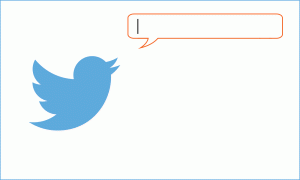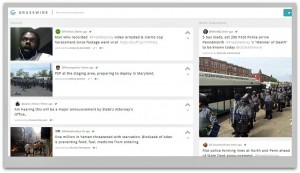Over the past year, the editors of the Los Angeles Times led a newsroom-wide effort to better marshal the power of social media in efforts to distribute the paper’s content more widely.
They have begun to replace automated tweets on their brand accounts with staff members and have also started using a service called Simply Measured, which analyzes reporters’ use of social media. And they set a goal to move all their bylined writers onto Twitter and Google+.
They’re not alone. Newspapers across the country are paying more attention to how to motivate staff members to post articles to social media as a means to drive site traffic, especially amid print circulation declines and the dwindling relevance of the front page (and even the homepage).
Efforts to ramp up social media efforts vary by company, but American Journalism Review interviews with a random selection of 18 newspapers in March and April found that most encourage or recommend staff to be on social media, but few require it. The majority of the papers place more responsibility on editors, social media managers or digital producers to bring readers to their sites — most reporters don’t have traffic quotas, according to interviews.
A select few newspapers, including The Los Angeles Times, require all bylined staff to be on social media.
Some Journalists Use Social Media — and Some Don’t.
The New York Times is among the papers examining its social media strategy. In its recently leaked internal innovation report, authors documented missteps in the paper’s social media efforts and how it was falling behind its rivals in terms of distributing its content online.
In one example, report authors pointed to how the paper handled its recent five-part “Invisible Child” series, which took a year to produce and documented the bleak prospects an 11-year-old homeless girl faces in New York City. The series didn’t receive any social media promotion prior to its publication because marketing and PR colleagues didn’t learn about it until it was too late, according to the report.
The report acknowledged that there are “no rules, but no real guidance, either” in regard to how its reporters should use social media. Going forward, the report recommended that leaders don’t require social media use, but “explicitly urge reporters and editors to promote their work …. and thank those who make the extra effort.”
The efforts among those in the news industry trying to mobilize journalists to promote their work online is rooted in the fact that social platforms drive traffic to news content. Out of all Facebook and Twitter users, half use the social networks to consume news. On Reddit, that number jumps to 62 percent, according to the Pew Research Center’s Journalism Project.
Even so, not all journalists have embraced social media. Nearly 60 percent of journalists were on Twitter in 2013, according to a survey done by Oriella PR Network.
San Francisco Chronicle managing editor Audrey Cooper said the lack of social media activity is more pronounced among print journalists.
“If you look at your average newspaper editor, they don’t have thousands of followers like the editors of BuzzFeed,” she said. “As a group we tend to have not embraced digital media as much. That’s not good or bad, but it does raise the question of how do you perform in that space if you’re not a user of digital media.”
Cooper’s hunch about newspaper editors may be right on.
Newly appointed New York Times Executive Editor Dean Baquet apparently has not tweeted yet, despite having more than 6,000 followers on his account. (A New York Times spokeswoman confirmed that that was indeed his account.)
By contrast, BuzzFeed Editor in Chief Ben Smith has tweeted more than 81,000 times from his verified account, with more than 178,000 followers.
‘It Really Takes An Entire Newsroom’ To Drive Traffic
The newspapers that mandate participation on social media emphasize a newsroom-wide approach to traffic growth. The Gannett-owned Jackson Clarion-Ledger, for instance, requires its writers to maintain Facebook and Twitter profiles and everyone on staff helps draw attention to the site, Executive Editor and Director of Audience Engagement Brian Tolley wrote in an email.
Editors and social media managers play a bigger role in audience-building than other staffers, though, Tolley said.
The Jackson Clarion-Ledger reporters on Twitter use a mixture of humor, information and personal tidbits to populate their feeds. On a recent week, reporter Clay Chandler posted updates about a political campaign that had canceled a meeting with the paper’s editorial board. They said “they’d reschedule, but try telling that to a broken heart,” he tweeted.
Crime reporter Therese Apel says on her profile she covers “crime/disaster/mayhem/war/etc.” and on a recent day she tweeted:
I wish I had time to read the newspaper.
— Therese Apel (@TRex21) May 20, 2014
The Indianapolis Star, too, emphasizes social media as an inherent part of every journalist’s job and plans to hold a workshop to that effect, Amy Bartner, the Star’s engagement and utility manager, wrote in an email.
“We view having a presence in online communities as vital as other skills a reporter must have in 2014, and include that in our job descriptions,” Bartner wrote. “Similarly, being out in the social communities — online or otherwise — is important to an IndyStar journalist’s role, and they choose the platforms based on where their readers or potential readers are. In many cases, this means Facebook and Twitter — but we’re involved in Pinterest, Instagram, LinkedIn, Google+ and other platforms where our audience is.”
The Orlando Sentinel and Sun Sentinel require their reporters to be on Google+ and link their bylines to their Google+ profiles, social media manager Lori Todd wrote in an email. The Tribune-owned papers also emphasize Twitter, and all the “bylined editorial staff” have a presence there, Todd wrote.
While the Sacramento Bee doesn’t require reporters to be on any social media platform, it strongly recommends Twitter and Facebook and is providing training for Google+. The paper is also implementing a policy on social media ethics, according to executive editor Joyce Terhaar.
One “person can’t be the sole driver of traffic,” Terhaar wrote in an email. “It really takes an entire newsroom.”
Social Media Guidelines for Newsrooms
Mallary Tenore, former managing editor of Poynter.org, said she doesn’t believe newspapers should require all staff to have social media accounts because people tend to have negative reactions to words such as “mandatory.”
And Tenore, now the managing director of Images & Voices of Hope, a nonprofit that shows how the media can be a force for good, said if newsrooms want to make it a requirement, they should train their staffs to use social media.
Newsrooms can also provide guidance by distributing social media guidelines, she said. She recommended NPR’s ethics handbook, which has a section on social media, which, amid other tips, counsels journalists to be transparent about what has and hasn’t been confirmed.
“If you’re going to invest the time in actually creating these guidelines,” Tenore said, “you need to make sure that they’re living, breathing documents that people are referring to and that you’re updating as you start using more social media tools.”
Former BBC journalist Nic Newman, a digital strategist, said newspapers should use social media to leverage their brand and traditional journalism values.
“[My advice would be] to try and take and adapt those values into social media rather than trying to be pushed by what social media’s doing into something you’re not really about,” he said.










Leave a Comment